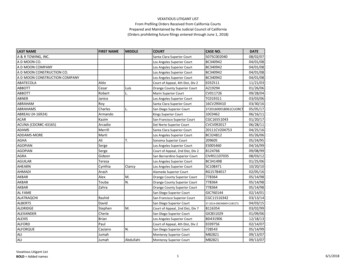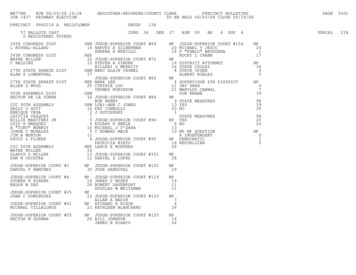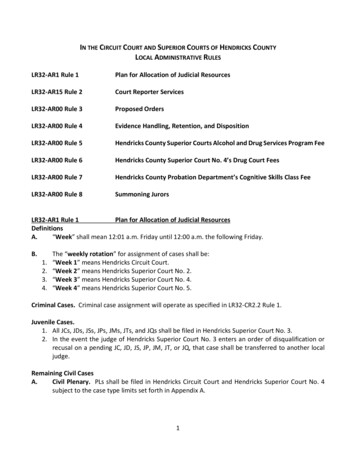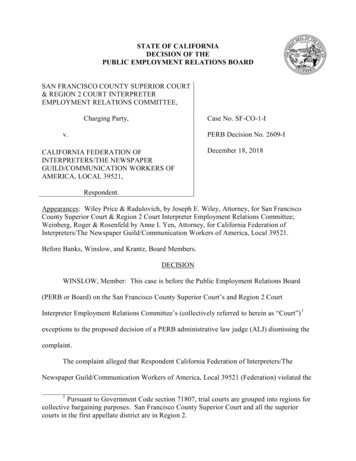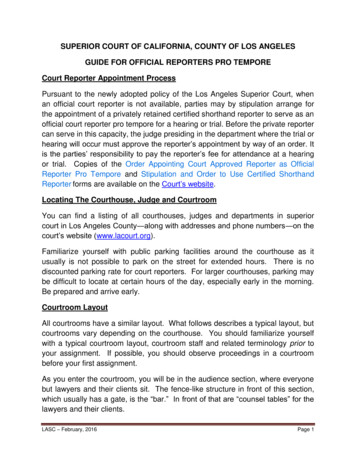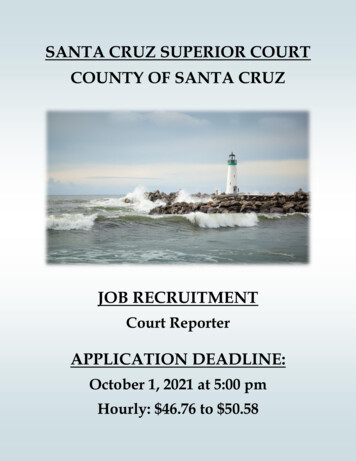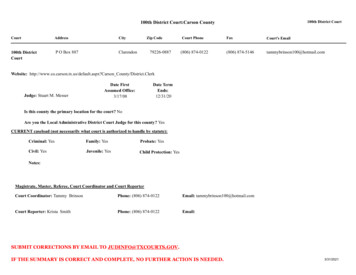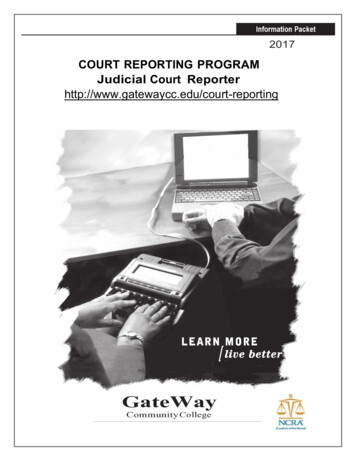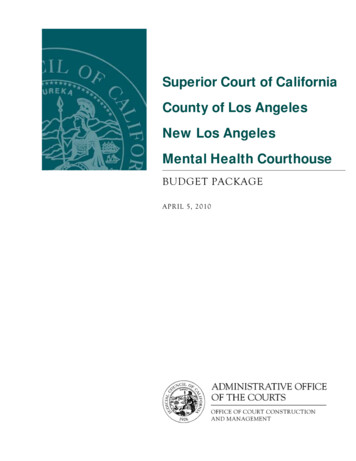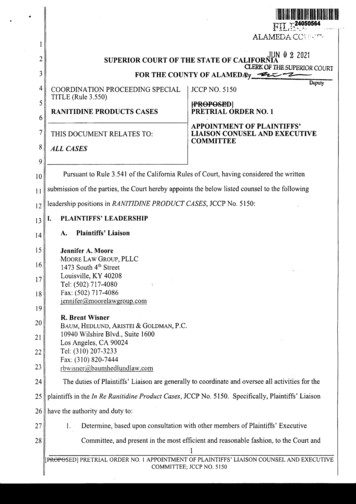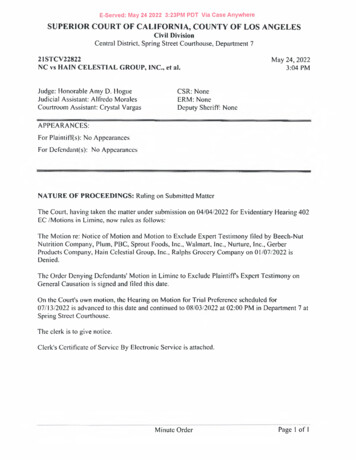
Transcription
E-Served: May 24 2022 3:23PM PDT Via Case AnywhereSUPERIOR COURT OF CALIFORNIA, COUNTY OF LOS ANGELESCivil DivisionCentral District, Spring Street Courthouse, Department 721STCV22822INC vs HAIN CELESTIAL GROUP, INC., et al.Judge: Honorable Amy D. HogueJudicial Assistant: Alfredo MoralesCourtroom Assistant: Crystal VargasMay 24, 20223:04 PMCSR: NoneERM: NoneDeputy Sheriff: NoneAPPEARANCES:For Plaintiff(s): No AppearancesFor Defcndant(s): No AppearancesNATURE OF PROCEEDINGS: Ruling on Submitted MatterThe Court, having taken the matter under submission on 04/04/2022 for Evidentiary Hearing 402EC /Motions in Limine, now rules as follows:The Motion re: Notice of Motion and Motion to Exclude Expert Testimony filed by Beech-NutNutrition Company, Plum, PBC, Sprout Foods, Inc., Walmart, Inc., Nurture, Inc., GerberProducts Company, Hain Celestial Group, Inc., Ralphs Grocery Company on 01/07/2022 isDenied.The Order Denying Defendants' Motion in Limine to Exclude Plaintiffs Expert Testimony onGeneral Causation is signed and Hied this date.On the Court’s own motion, the Hearing on Motion for Trial Preference scheduled for07/13/2022 is advanced to this date and continued to 08/03/2022 at 02:00 PM in Department 7 atSpring Street Courthouse.The clerk is to give notice.Clerk's Certificate of Service By Electronic Service is attached.Minute OrderPage 1 of 1
Reserved for Clerk's File SlampSUPERIOR COURT OF CALIFORNIACOUNTY OF LOS ANGELESCOURTHOUSE ADDRESS:FILEDSpring Street CourthouseSuper« Court ol CaMofraaCountyol LosAngates312 North Spring Street, Los Angeles, CA 9001205/24/2022PLAINTIFF5i rnR Calr Emeu!-.« OS«:/ CcxofCou*NCBy.DEFENDANT.A MoralesHain Celestial Group, Inc. et alCASE NUMBERCERTIFICATE OF ELECTRONIC SERVICECODE OF CIVIL PROCEDURE 1010.621STCV22822I, the below named Executive Officer/Clerk of Court of the above-entitled court, do hereby certify that Iam not apartytothecauseherein,andthatonthisdateIserved one copy ofthe Minute Order and Orderentered herein, on05/24/2022upon each party or counsel of record in the above entitled action, byelectronically serving the document(s) onCase Anywheresecure.caseanywhere.com onat05/24/2022from my place ofbusiness, Spring Street Courthouse 312 North Spring Street, Los Angeles, CA 90012in accordance with standard court practices.Sherri R. Carter, Executive Officer / Clerk of CourtDated: 05/24/2022By: A. MoralesDeputy ClerkLAC IV XXXLASC Approved 00-00CERTIFICATE OF ELECTRONIC SERVICECODE OF CIVIL PROCEDURE 1010.6CODE Civ. Proc. § 1013(f)
1FILEDSuperior Court of CaliforniaCounty of Los Angeles23MAY 24 20224-.hem R. Carte., .icer Clerk.depub¿ALFREDO MORALES5678SUPERIOR COURT OF THE STATE OF CALIFORNIA9FOR THE COUNTY OF LOS ANGELES1011NC, a minor,) Case No.: 21STCV228221213141516171819202122Plaintiff,v.) ORDER DENYING DEFENDANTS’ MOTION IN LIMINE TO EXCLUDEHAIN CELESTIAL GROUP, INC; BEECH ) PLAINTIFF’S EXPERT TESTIMONYNUT NUTRITION COMPANY; NURTURE, ) ON GENERAL CAUSATION)INC.; PLUM, PBC, dba PLUM ORGANICS;Hearing Dates:GERBER PRODUCTS COMPANY;)January31, February 1 -4 (Plaintiffs experts);WALMART, INC.; SPROUT FOODS, INC.;) March 14 (Defendants’ expert);RALPHS GROCERY COMPANY; AND) April 4, 2022 (closing arguments)DOES 1 THROUGH 100, INCLUSIVE,Defendants.) Dept.: 7)This is a complex litigation matter requiring exceptional judicial case management in23accordance with California Rules of Court, rule 3.400 et seq.24has been diagnosed with autism-spectrum disorder (ASD) and attention-deficit hyperactivity25disorder (ADHD). He alleges that his consumption of heavy metals (lead, arsenic, and/or mercury)26contained in baby foods manufactured by the Defendants caused his disorders. Defendants deny27that their food products contain harmful levels of heavy metals or caused Plaintiff to suffer any28harm. From their point of view, consumption of baby food could not have caused Plaintiffs ASDThe minor plaintiff in this action
1because ASD is a genetic disorder that develops prior to birth or in the weeks immediately2following birth.3To prevail at his jury trial, Plaintiff must present expert testimony establishing general and4specific causation. Under Sargon Enterprises, Inc. v. University of Southern California (2012) 555Cal.4th 747, 771-772 (Sargon), the Court has a “substantial gatekeeping responsibility” to ensure6that the expert causation opinions presented to the jury are not “based on a leap of logic or7conjecture.” At the Court’s suggestion and before the parties embarked on the expensive process8of discovery, the parties agreed to seek an early ruling on the question whether Plaintiffs experts’9opinions that heavy metals are capable of causing ASD and/or ADHD are admissible under10Sargon. To that end, Plaintiff retained four experts who presented written opinions, answered11questions in deposition, and testified in Evidence Code section 402 hearings: Drs. Beate Ritz and12Hannah Gardener, both epidemiologists; Dr. Michael Aschner, a neurotoxicologist; and Dr. Kevin13Shapiro, a pediatric neurologist.1 Defendants likewise retained an expert epidemiologist, Dr. Eric14Fombonne, who submitted a report, submitted to deposition, and testified in a section 402 hearing.15Defendants now move, in limine, to exclude Plaintiffs expert witness testimony, citing16four analytical gaps identified by their expert, Dr. Fombonne. Based on the briefing, argument,17and evidence, the Court concludes that Plaintiffs expert opinions that lead, arsenic and/or mercury18are capable of being a substantial factor in causing ASD and ADHD are not inadmissible under19Sargon.2021I.Allegations22Now seven years old, Plaintiff NC ate baby food contaminated with lead, mercury, and23arsenic (hereafter, “heavy metals”), causing him to develop ASD — diagnosed in 2016, when he24was age two years, nine months — and ADHD, diagnosed in 2020, when he was six. (First252627281 Evidence Code section 402, subdivision (b) permits the court to “hear and determine the question of theadmissibility of evidence out of the presence of the jury.”2
1Amended Complaint (Sept. 7, 2021)2negligence, he brings eight claims against Defendants as the manufacturers, distributors, and3retailers of the baby food. (Id. at1, 55-78.)2 On various theories of strict liability and82-206.)45II.Standards67A.8If “the complexity of the causation issue is beyond common experience, expert testimony9is required to establish causation.” (Webster v. Claremont Yoga (2018) 26 Cal.App.5th 284,290.)10There are two aspects to proof of causation of harm. Plaintiffs must establish “general causation”11by presenting expert scientific opinion that the allegedly toxic substances are capable of causing12the harm that the plaintiff suffered. Plaintiffs must also prove “specific causation” by presenting13expert testimony that, to reasonable degree of medical certainty, the plaintiffs harm was caused14by his or her exposure, ((bottle v. Superior . ourt (1992) 3 C?al. kpp.4th 1367, 1385, UendricJson15v. ConocoPhillips Co. (2009) 605 F. Supp. 2d 1142, 1155.) In this case, the issues of general16causation — whether heavy metals can contribute to ASD and ADHD — and specific causation17— whether heavy metals were a “substantial factor” in causing Plaintiffs ASD and ADHD18issues beyond common experience. (See Johnson & Johnson Talcum Power Cases (2019) 3719Cal.App.5th 292, 302 (Johnson & Johnson}.) Expert testimony is required.3Legal Standard: Admissibility of Expert Testimonyare20A court has an obligation to “keep unfounded [expert] opinions from the jury.” (People v.21Azcona (2020) 58 Cal.App.5th 504, 513.) “[U]nder Evidence Code sections 801, subdivision (b),22and 802, the trial court acts as a gatekeeper to exclude expert opinion testimony that is (1) based2324252627282 Plaintiff also alleges the baby food exposed him to cadmium, but his experts’ opinions do not address thismetal. (FAC, 1 1.)3 This Order only addresses Plaintiffs experts on general causation, that is, the issue of whether heavy metalscan cause ASD and ADHD. As the term implies, general causation is mostly abstracted from specific causation andthe specific allegations of this case. This Order does not consider, for example, the dosages of heavy metals to whichPlaintiff was allegedly exposed, the time frame when he was allegedly exposed, or whether heavy metals were asubstantia] factor in causing his disorders.-3-
1on matter of a type on which an expert may not reasonably rely, (2) based on reasons unsupported2by the material on which the expert relies, or (3) speculative.” (Sargon, supra, 55 Cal.4th at pp.3771-772, page number omitted.) “This means that a court may inquire into, not only the type of4material on which an expert relies, but also whether that material actually supports the expert’s5reasoning. ‘A court may conclude that there is simply too great an analytical gap between the data6and the opinion proffered.’” (Id. at p. 771.)7However, a court excludes expert opinion cautiously, keeping from the jury only “clearly8invalid and unreliable” opinion that “fails to meet the minimum qualifications for admission.”9(Sargon, supra, 55 Cal.4th at p. 772; Davis v. Honeywell Internal. Inc. (2016) 245 Cal.App.4th10477, 492 (Davis).) A court does not “choose[] between competing expert opinions . weigh an11opinion’s probative value . [or] resolve scientific controversies.” (Sargon, at p. 772.) It instead12“conducts a ‘circumscribed inquiry’ to ‘determine whether, as a matter of logic, the studies and13other information cited by experts adequately support the conclusion that the expert’s general14theory or technique is valid’” — ensuring, in short, “that an expert, whether basing testimony upon15professional studies or personal experience, employs in the courtroom the same level of intellectual16rigor that characterizes the practice of an expert in the relevant field.” (Ibid.) “If the opinion is17based on materials on which the expert may reasonably rely in forming the opinion, and flows in18a reasoned chain of logic from those materials rather than from speculation or conjecture, the19opinion may pass, even though the trial court or other experts disagree with its conclusion or the20methods and materials used to reach it.” (Davis, at p. 429 [citing Sargon, at pp. 771-772].)2122B.23Epidemiology is the study of the “incidence, distribution, and etiology” of human disease.24(Green et al., Reference Manual on Scientific Evidence (3d ed.) Reference Guide on25Epidemiology, p. 551 (“Reference Manual”).)4 Based on the assumption that disease is notScientific Standard: Inferring Causation from Epidemiological Data2627284 California courts use the Reference Manual to evaluate scientific evidence. (See Duran v. U.S. BankNational Assn. (2014) 59 CaL4th 1,38; Johnson & Johnson, supra, 37 Cal.App.5th 292 at p. 303, fn. 4.)-4 -
1distributed randomly in a population, an epidemiological study “identifies agents that are2associated with an increased risk of disease in groups of individuals, quantifies the amount of3excess disease that is associated with an agent, and provides a profile of the type of individual who4is likely to contract a disease after being exposed to an agent.” (Id. at pp. 551-552.) Just because5an agent and a disease are associated, however, does not necessarily mean the agent causes the6disease.7strengths and weaknesses of a study’s design and implementation, and judge how the study’s8findings fit with other scientific knowledge.9causation; rather causation is a judgment for epidemiologists and others interpreting the10(Ibid.) To assess whether an association is causal, a scientist must understand the(Id. at p. 553.) “[E]pidemiology cannot proveepidemiologic data.” (Id. at p. 598.)11The two main types of human epidemiologic studies are experimental and observational.12An experimental study divides test subjects into one of two groups, exposes one group to an agent,13and observes the results compared to the other, unexposed group. (Reference Manual, p. 555.)14Because experimental human studies allowing exposure to potentially toxic agents are unethical,15epidemiologists typically rely on observational studies. Observational studies typically observe16the outcomes in people who were exposed to an agent compared to the outcomes in people who17were not exposed to the agent. (Id. at pp. 555-556.) Observational studies can be of several18different designs, but the two main designs are a) cohort studies and b) case-control studies. (Id.19at p. 556.) If a study observes a disease is associated with an agent, researchers first consider20alternative explanations for the association, particularly a) the possibility it was observed by21chance or b) it resulted from bias in the study’s methodology, or c) it was observed not because22the agent caused the disease, but because both the disease and the agent were jointly caused by a23third, confounding factor. (Id. at pp. ts assess whether the association is causal using the nine Bradford Hill factors:(1)Temporal relationship: Exposure to an agent must occur before a disease develops— “[without exposure before the disease, causation cannot exist.”28-5-
1(2)Strength of the association: Relative risk, “one of the cornerstones for causal2inferences,” measures how often a disease is observed in people exposed to an agent3relative to how often the disease is observed in people not exposed to the agent.4(3)Dose-response relationship: A dose-response relationship exists if the greater the5exposure to an agent, the greater the risk of disease. Higher exposures generally,6but not always, increase the incidence or severity of a disease. A dose-response7relationship is therefore “strong, but not essential” evidence of a causal relationship.8(4)Replication of the findings: As in many areas of science, a causal relationship is9more likely if a study’s findings can be replicated, especially in different conditions10or populations. “Rarely, if ever, does a single study persuasively demonstrate a11cause-effect relationship.”12(5)Biological plausibility (coherence with existing knowledge): Given what is known13about the biological “mechanisms by which the disease develops,” can the agent14plausibly cause the disease? If it is biologically plausible that an agent causes a15disease, then it “lends credence to an inference of causality.”16(6)Consideration of alternative explanations: As discussed above, a researcher should17consider whether an observed association resulted from chance, bias, or18confounding.19(7)Cessation of exposure: If an agent causes a disease, then risk of the disease should20decrease when exposure to the agent stops. Often data is not available showing the21effects of ending an exposure, but if the data is available and it shows a reduction22in the incidence of disease, then it “strongly” supports a causal relationship.23(8)Specificity of the association: “An association exhibits specificity if the exposure24is associated only with a single disease or type of disease.”25specificity may strengthen the case for causation, [but] lack of specificity does not26necessarily undermine it where there is a good biological explanation for its27absence.”28-6-“[E]vidence of
1(9)Consistency with other knowledge: Data showed that as cigarette sales in the2United States increased, for example, so did men’s rate of death from lung cancer.3This other knowledge was consistent with a causal relationship between smoking4and lung cancer.5(Reference Manual, pp. 597-607.) These factors are not a rigid formula. “One or more factors6may be absent even when a true causal relationship exists. Similarly, the existence of some factors7does not ensure that a causal relationship exists.8association and considering these factors requires judgment and searching analysis, based on9biology, of why a factor or factors may be absent despite a causal relationship, and vice versa.”10Drawing causal inferences after finding an(Id. at p. 600, footnote omitted.)11Both sides in this case and courts agree: a Bradford Hill analysis is an accepted12epidemiological method to infer causation from data that shows an association between an13exposure and a disease. Defendants contend, however, that Plaintiffs experts’ Bradford Hill14analysis was flawed under Sargon.1516111.The Experts17Two of Plaintiffs four experts, Drs. Ritz and Gardener, are epidemiologists who conducted18a Bradford Hill analysis. The other two experts are Dr. Aschner, a neurotoxicologist, and Dr.19Shapiro, a pediatric neurologist, both of whom opine on one Bradford Hill factor, biological20plausibility.21“analytical gaps” in Plaintiffs experts’ methodology.2223Defendants proffered their own expert, Dr. Eric Fombonne, who identified fourThis section summarizes the experts’ credentials (which are not at issue on this motion),their opinions, and methodology.2425A.General Causation Experts1.Dr. Ritz, Epidemiologist262728-7-
1Dr. Beate Ritz is Professor of Epidemiology at the UCLA Fielding School of Public Health2and holds co-appointments in the Environmental Health Sciences and Neurology at the UCLA3School of Medicine. (Declaration of Pedram Esfandiary in Opposition (“Esfandiary Deci.”),4Exh. 22, p. 3 (“Ritz Report”).) She holds an M.D. (1984) and a doctoral degree in Medical5Sociology (1986) from the University of Hamburg, and a doctoral degree in Epidemiology (1995)6from UCLA, (¡bid.) She primarily researches the health effects of occupational and environmental7exposures, focusing on the effects of pesticides and air pollution on chronic diseases including8neurodevelopmental disorders and diseases. (Ibid.)23,9She opines that exposure to mercury, arsenic, and lead during sensitive developmental10periods in early childhood can cause ASD, and lead exposure can cause ASD at relatively low11concentrations; and exposure to lead during sensitive developmental periods in early childhood12can cause ADHD, even at low levels of exposure. (Ritz Report, pp. 4-5.)5 Her opinion is based13on peer-reviewed studies on the relationship between exposure to heavy metals and ASD, and lead14and ADHD. To reach her opinion, she applied the Bradford Hill factors to the studies’ findings.15(Id. atpp. 12-15, 22-49.)16172.18Dr. Hannah Gardener has been an epidemiologist at the University of Miami Miller School19of Medicine for over 14 years. (Esfandiary Deci., Exh. 20, p. 3 (“Gardener Report”).) She holds20a Doctorate in Epidemiology and a minor in Biostatistics (2007) from the Harvard School of Public21Health. (Ibid.) Her research focuses on diet and other environmental causes of neurological22diseases; she has published over 100 peer-reviewed manuscripts. (Ibid.) She has studied heavy23metals in consumer products since 2015, and is currently studying heavy metals in prenatal24vitamins, CBD, and pet food. (Ibid.) Her areas of expertise include risk factors for neurologicalDr. Gardener, Epidemiologist252627285 All of Plaintiffs experts state their opinions “to a reasonable degree of scientific certainty,” but since thisstatement is a legal conclusion, the Court omits it from the summary.8
1outcomes, environmental health, and epidemiological methods. (Id. at pp. 3-4.) She currently co 2teaches a course on epidemiological methods and biostatistics. (Ibid.)3She opines that lead, arsenic, and methylmercury accumulation in the body can cause the4development of ASD, and lead accumulation in the body can also cause the development of5ADHD. (Gardener Report, 4-5.) Like Dr. Ritz, she based her opinion on peer-reviewed studies,6and reached her opinion by applying the Bradford Hill factors to the studies’ findings. (Ibid.)78B.Biological Plausibility Experts101.Dr. Aschner, Neurotoxicologist11Dr. Michael Aschner holds multiple titles at the Albert Einstein College of Medicine in12The Bronx, New York, including Professor of Molecular Pharmacology, Professor of13Neuroscience, Professor of Pediatrics, Investigator at the Rose F. Kennedy Intellectual and14Developmental Disabilities Research Center, and Member of the Nathan Shock Center of15Excellence in the Basic Biology of Aging. (Esfandiary Deci., Exh. 5, p. 4 (“Aschner Report”).)16He holds a Ph.D. in Anatomy and Neurobiology (1985) from the University of Rochester, School17of Medicine and Dentistry in Rochester, New York, where he researched the potential neurotoxic18effects of methylmercury. (Ibid.) Among his many credentials, he is a European Registered19Toxicologist, a Fellow of the American Academy for the Advancement of Science, Chair of the20External Advisory Board of the National Center for Toxicological Research (a center of the United21States FDA), and past president of both the International Neurotoxicology Association and the22International Society for Trace Element Research in Humans. (Id. at p. 5-7.) He has authored23over 800 peer-reviewed articles, 100 book chapters, and hundreds of abstracts, and estimates his24work has been cited nearly 49,000 times. (Id. at pp. 7-8.) As a neurotoxicologist, he specializes25in assessing the adverse effect of pharmaceuticals, non-therapeutic chemicals, and other potential26toxins on humans with an emphasis on neurological outcomes, and his research interest is the27interaction between genetic and environmental triggers of brain diseases. (Id. at p. 5.) He has9289
1experience interpreting epidemiological studies and modeling in vivo and in vitro blood-brain2barrier and mechanisms of neurodegeneration. {Ibid.)3He opines there are “well-established” mechanisms by which lead, arsenic, and mercury4can pass through the blood-brain barrier and cause “significant and permanent” disruption to the5brain’s neuropathways. (Aschner Report, p. 9.) He further opines that lead, arsenic, and mercury6exposure can cause ASD in children, and lead exposure can cause ADHD in children, via7“biologically plausible” mechanisms. {Ibid.) Lastly, exposure to mixtures of lead, arsenic, and8mercury “will lead to the additive and synergistic effects of the[] metals, given that they share9common toxicological modes-of-action.” {Ibid.) His conclusions are “supported by a wealth of10epidemiological data” and the metals’ toxicological profiles. {Ibid.)11Dr. Aschner did not conduct a Bradford Hill analysis, as he is not an epidemiologist.12(Aschner Report, p. 12.) Instead, based on his 35-plus years of professional experience studying13the neurotoxicity of heavy metals, he reviewed the scientific literature on the risk of contracting a14disease at any given dose and considered whether the toxicological evidence supports finding15biological plausibility. {Id. at p. 12-13.)16172.18Dr. Kevin Shapiro is Medical Director and Clinical Executive for Research and19Therapeutic Technologies at Cortica Healthcare, an organization that provides “comprehensive20assessment and therapeutic services for children with autism and other neurodevelopmental21disorders.” (Esfandiary Deci., Exh. 1, p. 3 (“Shapiro Report”).) He is also on the neurology staff22at Children’s Hospital Los Angeles and is an affiliate staff member at Rady Children’s Hospital in23San Diego.24psychology from Harvard University (2008). {Ibid.) He divides his work at Cortica Healthcare25between clinical care — evaluating, treating, and following-up with children who have26neurodevelopmental conditions including ASD and ADHD — and research into the “efficacy of27novel treatment paradigms” for symptoms of ASD and ADHD. {Id. at p. 4.)Dr. Shapiro, Pediatric Neurologist{Ibid.) He holds an M.D. from Harvard Medical School (2008) and a Ph.D. in28io
1While ASD has a genetic component, he opines that genetic factors alone cannot explain2the varied presentation and severity of ASD behaviors.3mechanisms, environmental risk factors, and gene-environment interactions also contribute to the4emergence of [ASD] symptoms.” (Ibid.) Known environmental risk factors for ASD include5“exogenous agents that affect brain function” by altering cellular signaling and neurotransmitter6release and by increasing oxidative stress and inflammation, all of which can occur following7exposure to heavy metals in utero or within the first two years of life. (Ibid.) The mechanisms by8which heavy metals affect neuronal function and development in vivo and in vitro overlap “to a9significant degree” with the biological pathways that are implicated in ASD pathogenesis. (Id. at10(Shapiro Report, p. 5.) “Epigeneticp. 6.)11He reached his opinions “using the methods, procedures, and techniques typically used by12experts” in his field, relying on his ten-plus years of clinical experience diagnosing and treating13ASD, his clinical research into the biological pathogenesis of ASD, and his clinical and research14experience on how neurological injuries might produce core ASD symptoms. (Shapiro Report, p.156.) He also reviewed the “extensive” literature on ASD — its etiology, biological mechanisms,16and risk factors — focusing on whether the neurological effect of exposure to lead, mercury, and17arsenic is clinically relevant to the pathogenesis of ASD. (Ibid.)1819C.20Dr. Eric Fombonne is a Professor in the Department of Psychology and the Director of the21Autism Research Institute on Development and Disability and the Child Development and22Rehabilitation Center at Oregon Health and Safety University. (Declaration of Ali Mojibi in23Support (“Mojibi Deci.”),24conducted epidemiological surveys; as a clinician, diagnosed and treated children with ASD and25ADHD; and as a teacher, lectured and trained clinicians on the treatment, diagnosis, and causes of26ASD, and trained researchers on how to conduct epidemiological studies on autism. (Id. at pp. 3-276.) He belongs to several professional associations, including the International Society for Autism28Research and the Scientific Committee of the Association for Research on Autism and InfantileDefendants’ Expert6, Exh. 5, p. 3 (“Fombonne Report”).) As a researcher, he has11 -
1Psychosis; has published over 350 peer-reviewed articles; and regularly reviews research articles2on autism for publication. (Ibid.)34He testified Plaintiffs’ experts’ opinions contain the following four “analytical gaps” orleaps of logic. They:5(1)6speculated that the temporality factor was satisfied by studies that could “notestablish[]” temporality;7(2)8relied on studies that compared heavy-metal concentrations to scores on behavioralquestionnaires, rather than clinical ASD diagnoses,9(3)10reached their conclusions “in the face of a body of evidence that finds no consistentassociation between heavy metal exposure and ASD,” and11failed to consider “what is known about ASD.”(4)12As Dr. Fombonne put it, “Plaintiffs expert[s] did not follow a methodology [that] is rigorous13enough and would be accepted in admitting the standards of the epidemiological community.”14(Defendants’ Closing Arguments, Sargon Hearing (Apr. 4, 2022) Slide No. 5 [citing Hearing15Transcript (Mar. 14, 2022) at p. 15], Slide No. 8.)1617IV.Analysis18The first part of the Court’s analysis addresses the four analytical gaps identified by19Defendants’ expert and the second part addresses arguments presented in Defendants’ moving20papers.2122A.23The Court first considers the four “analytical gaps” Dr. Fombonne identified in Plaintiffs’24experts’ methodology: (1) speculative conclusions resting on studies that lack temporality, (2)25improper reliance on behavioral questionnaires, (3) lack of consistent association, and (4) failure26to account for what is known about ASD.Dr. Fombonne’s “Analytical Gaps”27281.Temporality- 12-
1According to Dr. Fombonne, few of the peer-reviewed studies underlying Dr. Ritz’s and2Gardener’s opinions are “capable of establishing temporality,” the Bradford Hill factor that3considers whether there is evidence that the exposure preceded the disease. (Reference Manual,4p. 601.) “Although temporal relationship is often listed as one of the many factors in assessing5whether an inference of causation is justified, this aspect of a temporal relationship is a necessary6factor: Without exposure before the disease, causation cannot exist.” {Ibid.)7Drs. Ritz and Gardener relied on several studies that measured the amounts of heavy metals8present in human “biomarkers” such as blood, urine, hair, and nails. The problem, according to9Dr. Fombonne, is that most of these studies relied on exposures that occurred too late in time.10Because, in his opinion, ASD is a genetic disorder that develops before birth possibly extending11to shortly after birth, the relevant period of exposure is pre-natal. To illustrate his point, Dr.12Fombonne cited approvingly the Doherty et al. (2020) study, which measured concentrations of13metals in maternal and infant toenails. (Mojibi Deci., Exh. 17, p. 2 [peer-reviewed, published as14Periconceptional and prenatal exposure to metal mixtures in relation to behavioral development15at 3 years of age (2020) Environmental Epidemiology, pp. 1-8].) The researchers in that study16collected maternal toenails at 27 weeks of gestation and 4 weeks postpartum, and collected infant17toenails at 6 weeks after birth.618concentrations “reflect exposures approximately 6-12 months before toenail collection,” whereas19infant toenails grow faster — though they admitted the literature on this issue is “sparse,” infant20toenails “collected at 6 weeks after birth likely represent exposures that occurred in late pregnancy21and early neonatal life.” {Ibid.) The study’s measured effect was a child behavioral assessment22called the Social Responsiveness Scale, 2nd edition, completed by the mothers when their children23were three years old. {Ibid.) The Doherty study researchers therefore measured metal exposure24before they measured the potential effect, which in Dr. Fombonne’s opinion means the Doherty25study “is capable of establishing” temporality, that is, capable of establ
Clerk's Certificate of Service By Electronic Service is attached. Minute Order Page 1 of 1. SUPERIOR COURT OF CALIFORNIA . accordance with California Rules of Court, rule 3.400 et seq. The minor plaintiff in this action . of discovery, the parties agreed to seek an early ruling on the question whether Plaintiffs experts' .
